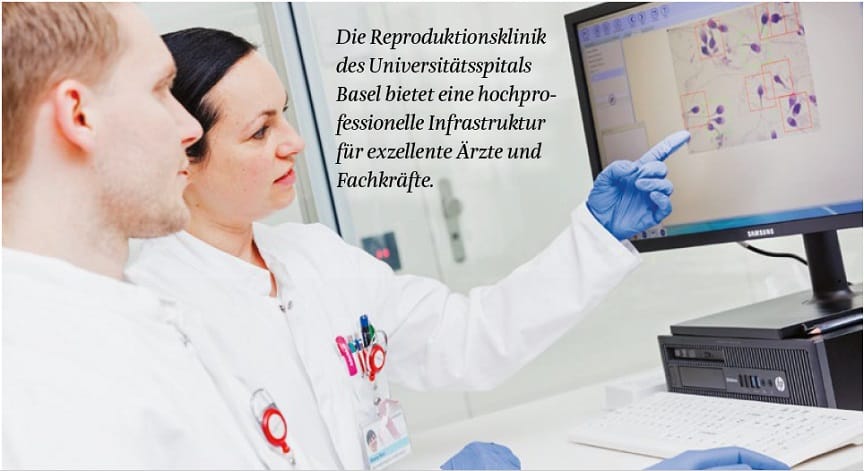Equipped for the top league of reproductive medicine
The Women's Clinic of the University Hospital Basel (USB), as one of the five university women's clinics in Switzerland, is a success story. It is a leader in several areas of gynaecology. Accordingly, demand is growing steadily. At present, the gynaecological clinic has around 400 employees and over 60,000 outpatient consultations, 2,600 births and more than 2,000 surgical procedures every year.

Major changes in the hospital environment are a challenge: the existing space at the gynaecological clinic of the University Hospital Basel was no longer sufficient, despite the new building at Clinic I and its occupation in 2003 as well as multiple optimisations. The central location in the main campus is very popular and no department wants to leave it. This was the initial situation for the project, which led to a very successful outsourcing of human reproductive medicine and gynaecological endocrinology.
External solution was needed
After an in-depth analysis of the gynaecological clinic with its six units and many internal discussions with chief physicians, doctors and nursing staff, all departments expressed additional space requirements. Taking into account the processes and the specific needs of the service providers concerned (doctors, nursing, laboratories, administration, technical and infrastructure staff), research and other parties involved, as well as locally adjacent units of the USB (Urology, Medicine, etc.), it became clear that the solution to the space problem had to be found externally.
Reproductive medicine outsourced
In principle, none of the units was interested in leaving the good location at this time. An internal clarification regarding internal networking, market development and the competitive situation in Switzerland produced a favourite: reproductive medicine. This unit has seen a disproportionate increase in patients in recent years and already had extreme space problems. In parallel, the legal framework of permissible treatments in this field was expanded in Switzerland in autumn 2017 for the benefit of patients. Due to these new possibilities and the social change, double-digit growth rates are expected for the coming years. All this was a good indication for the selection of this field. A special marginal condition in reproductive medicine has significantly supported this decision: Due to the social stigma of "non-natural" childbearing and the thus required discretion of the actually "healthy " patients, a separation from other units such as obstetrics and pregnancy medicine is advantageous. Therefore, the decision was made to move forward: the spatial separation of reproductive medicine, newly as an independent clinic. The removal of Reproduction freed up space on the main campus, which is now used by the other units of the Women's Clinic.
Challenging consensus building
After a successful search for a location on Vogesenstrasse - just under 1 km from the main campus - concrete operational planning began. The site found had to be completely rebuilt to meet the requirements of a modern and leading clinic. Finding a consensus between internal and external specialists was a major challenge. The views, including needs and priorities, as well as the language between hospital management, doctors, laboratories, nursing, psychology, administration, technical staff, authorities and architects/specialist planners vary immensely. Finding consensus and consolidation in a layout suitable for business management and for a sustainable operational organization with corresponding processes was our central task. The aim was to optimise all processes in terms of patient flow, to standardise wherever possible and to take patient safety into account. The new process definitions also laid important steps towards future automation, such as the use of RFID tags.
The challenging path that was successfully taken required several in-depth clarifications of needs, planning in variants and a great many individual and team discussions. Thanks to the common goal, the great commitment and willingness to compromise of all those involved, the limited but realistic investment budget and the time invested by the user groups, a very good solution was found. The solution contains a great many innovative and forward-looking ideas from all those involved.
Use of established tools
In the course of the project, the project team used various established supporting methods and tools: Wallchart techniques, structured questionnaires, lean management explanation models, project management and systems engineering methods according to BWI/ETH Zurich. In addition, some of the methods and tools developed by Dr. Acél & Partner AG were also used: the company's own key figure system as a benchmark for floor space shares (LayAn/LayPlan), ProMap for process analysis and design, and the company's own checklists. Due to the location outside the USB main campus, many logistical challenges also had to be solved, e.g. the transport of samples to the central laboratory medicine and pathology departments at the USB, the supply of laundry, consumables and media (gases, laboratory chemicals), the entire waste disposal, the cleaning service as well as the technical maintenance of equipment including the coverage of emergencies in case of malfunctions. The result is a new, fully functional external unit that is well connected to the central USB units such as sterilization, central warehouse, etc. All these challenges were successfully solved in time for the opening and commissioning of the new reproduction clinic.
One of the most modern reproduction clinics in Europe
The (re)construction work for the new centre cost around CHF 10 million and took 15 months. The new premises with 1600 m2 are modern and inviting. Particularly noteworthy are the two, multiple certified, special high-tech laboratories, which allow many new and future examinations and treatment methods. The location is easily accessible by public transport and offers bicycle parking and free parking for patients in the underground car park of the building. From there, the reception of the Reproduction Clinic can be reached directly by its own lift.
As a result, one of the most modern reproductive clinics in Europe was created with a lot of potential for the future. The clinic has been fully operational on schedule since 1 January 2018. At the new location, the clinic provides a comprehensive, multidisciplinary range of services for women and men. After 15 months of full operation, it is evident that the access via the underground car park is particularly appreciated and used by patients as a discreet entrance. The ambience of the new clinic is modern, friendly and bright. Everyone likes it very much and the employees are happy to be in the new place.
A pioneering reproduction clinic was built here to offer excellent doctors and specialists an ideal base with highly professional infrastructure and optimal processes that are second to none. It was a pleasure to be significantly involved in the planning of this USB reproduction clinic.









